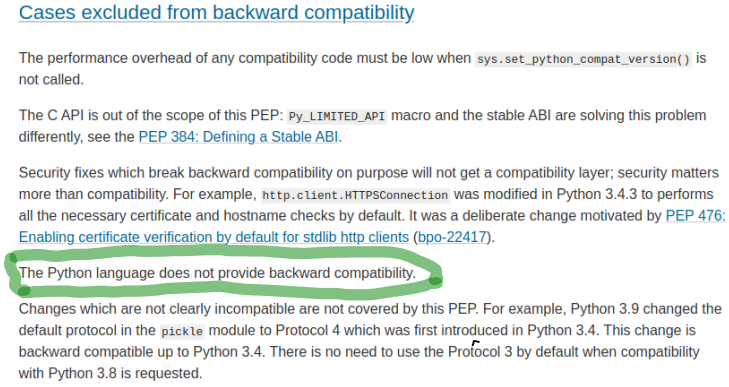The Challenges of Python Migration: Lessons from C++ and Beyond
One project that confirmed the need for caution and conservatism when estimating deadlines involved migrating a massive codebase of over 4,000 Python files and 250+ open-source libraries from Python 3.6 to 3.10. What was initially seen as a straightforward task, expected to take just a few weeks, ended up consuming more than a year. While upgrading to a new minor version might sound simple, Python’s frequent version incompatibilities can turn it into a daunting challenge. This isn’t the first time Python’s lack of emphasis on backward compatibility has complicated such migrations, and it likely won’t be the last.
As we read in PEP 606 – Python Compatibility Version python does not provide backward compatibility:

Historical Challenges with Python Version Upgrades
The challenges faced during this Python version migration shouldn’t come as a
surprise—this isn’t the first time such difficulties have occurred. The
transition from Python 2 to 3 spanned many years, with a significant portion of
the user base slow to migrate their codebases. Despite heavy promotion from
books, forums, conferences, and the entire “organized” Python community, the
broader “real world” community was hesitant to make the switch.
When Python 3 was released in 2008, it introduced compatibility issues that
disrupted existing applications to the extent that even early adopters like
Google decided against migrating. When I left Google in 2017, there wasn’t a
single line of Python 3 in its code repository, here you can read more about
the Google’s python sunset which took well over a decade to complete.
Google wasn’t alone in resisting the upgrade. From 2008 to 2017, I worked with
numerous companies—ranging from small startups to large enterprises—and none of
them had adopted Python 3.
Contrasts with Other Languages
Writing code in Python differs significantly from languages like C++ or Java.
While C++ and Java adhere strictly to object-oriented principles, Python takes
a more flexible approach. This flexibility often leads to Pythonic code that
lacks stringent OOP guidelines. Encapsulation, a key OOP principle, is often
overlooked in Python, and direct data access is common. Although Python
leverages syntactic sugar like named tuples and dataclasses to streamline code,
it diverges from traditional OOP patterns. Additionally, Python attempts static
typing but falls short of the strict type safety found in compiled languages.
Its approach to backward compatibility prioritizes progress over consistency,
causing frequent upgrade challenges.
C++ vs Perl or struggling for backwards compatibility vs ignoring it
The complexities of Python migration have deepened my respect for Bjarne
Stroustrup and the C++ committee for their meticulous approach to language
evolution. C++ is often criticized for slow feature adoption, such as Unicode
and functional programming constructs. However, this deliberate pace has
ensured remarkable consistency and backward compatibility, allowing decades-old
code to still compile with modern compilers.
The pressure of tight deadlines can lead to overly optimistic decisions and an underestimation of crucial design elements
C++ is known for its backward compatibility, with only a few minor exceptions, contrasting sharply with Perl 6, which suffered a decline after breaking compatibility. This serves as a cautionary tale about the consequences of neglecting compatibility. In my experience, backward compatibility is often overlooked in fast-paced development environments. Here, the pressure of tight deadlines can lead to overly optimistic decisions and an underestimation of crucial design elements. Compatibility issues frequently arise from incomplete design phases and a lack of thorough analysis of domain requirements.
The decision to break backward compatibility in Perl 6, now known as Raku, had a profound impact on the Perl community and its adoption. By introducing significant changes incompatible with Perl 5, the language effectively split the community into two camps. Many developers, who had invested heavily in Perl 5 ecosystems, chose not to migrate to Perl 6 due to the steep learning curve and the extensive rewrites required. This division diluted community efforts and resources, leading to a slowdown in collaborative development and innovation within the Perl ecosystem.
This fragmentation and the slow adoption of Perl 6 had broader implications, contributing to a decline in Perl’s popularity. While other languages like Python and Ruby continued to gain traction by incrementally building on their existing foundations, Perl faced challenges in maintaining its user base. The experience of Perl 6 underscored the importance for programming languages to balance innovation with stability, providing clear paths for migration and ensuring that new features do not alienate long-standing users.
Striking the Balance: Navigating Python’s Strengths and Challenges
Many developers may not delve into the deeper programming paradigms offered by lower-level or more imperative languages. This can lead to a limited understanding of essential concepts like design patterns, robust object-oriented principles, and interface-based design.
Python’s dominance in the programming world is undeniable, drawing in new programmers with its simplicity and versatility. However, this accessibility comes with a risk: many developers may not delve into the deeper programming paradigms offered by lower-level or more imperative languages. This can lead to a limited understanding of essential concepts like design patterns, robust object-oriented principles, and interface-based design. Additionally, the reliance on third-party libraries—often poorly documented and prone to compatibility issues with newer Python or other library versions—requires careful consideration.
Striking a balance between innovation and backward compatibility is vital.
Reflecting on my experiences with Python migrations and its evolution, it is evident that striking a balance between innovation and backward compatibility is vital. While Python’s flexibility offers undeniable benefits, ensuring stability and predictability remains essential. This balance highlights the timeless importance of consistent design principles, akin to those in languages like C++. As technology progresses, fostering environments that prioritize well-considered design processes will aid in developing robust, adaptable software solutions capable of withstanding the test of time. Such an approach can safeguard against the pitfalls of naivety and encourage a deeper, more comprehensive understanding of software development.
